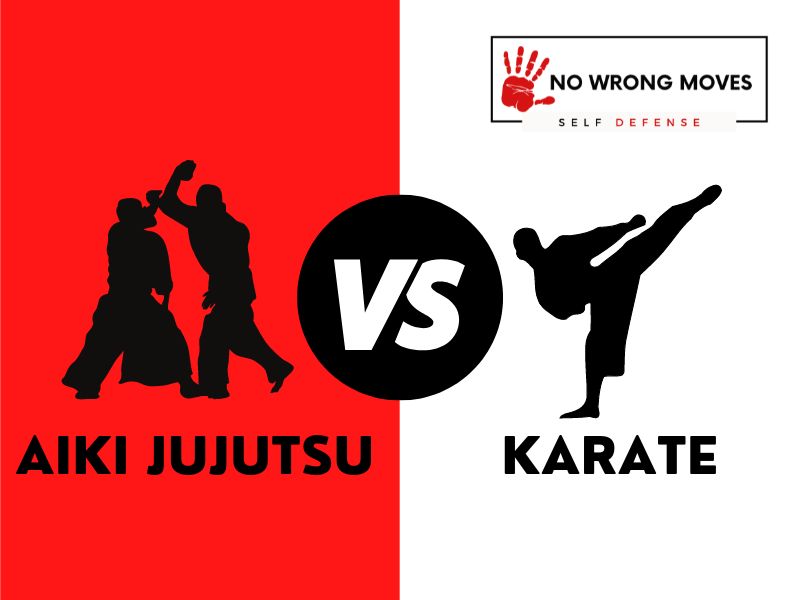
- What We Know About Aiki Jujutsu
- What We Know About Karate
- Key Elements Of Aiki Jujutsu
- Key Elements Of Karate
- Aiki Jujutsu Rankings & Levels
- Karate Rankings & Levels
- Aiki Jujutsu Vs. Karate Attire
- What A Typical Aiki Jujutsu Training Session Looks Like
- What A Typical Karate Training Session Looks Like
- Aiki Jujutsu Movies
- Conclusion: Aiki Jujutsu Vs. Karate
Today, we are going to end the long-standing debate of Aiki Jujutsu Vs. Karate! People (especially those online) go back on forth on which discipline is better.
Some say that Aiki Jujutsu is more fluid and instinctive, while others argue that Karate is more powerful and straightforward. So which is it, and why?
Well...
The main difference between karate and aiki jujutsu is the focus on striking versus grappling techniques. Karate emphasizes punches, kicks, and strikes, while in aiki jujutsu, practitioners use joint locks and throwing techniques to control or defeat an opponent.
Both arts also have philosophical components that emphasize respect and self-improvement.
In terms of which is better, it ultimately depends on the individual and their preferred style of combat. Some may find the striking techniques of karate more applicable for self-defense situations, while others may prefer the grappling methods of aiki jujutsu.
Let's take a closer look at both, and hopefully, when we're done and dusted, you'll have a better idea of which might be the best fit for you.
What We Know About Aiki Jujutsu
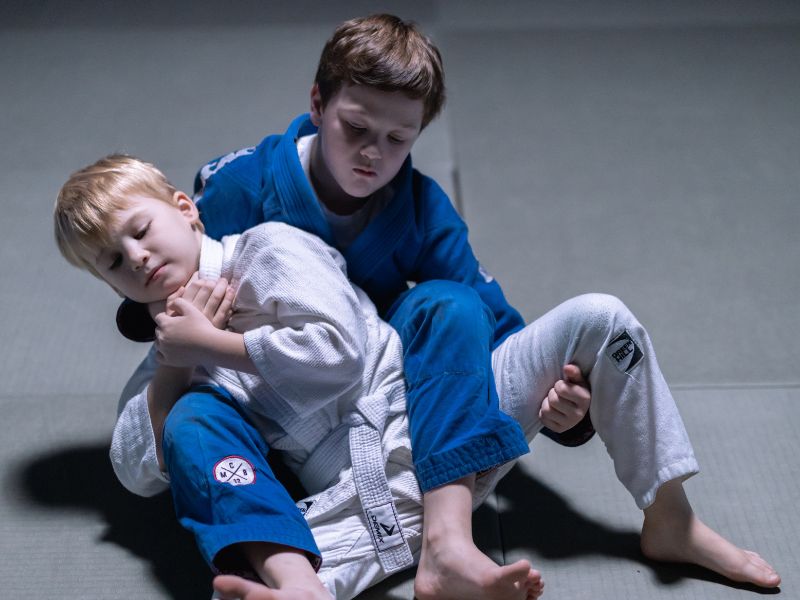
Aiki Jujutsu is a martial art that involves harmonizing your own energy with that of your opponent in order to redirect it in a way that suits your needs.
Instead of meeting force head-on, Aiki Jujutsu practitioners use Kempo-Jutsu's striking and evasive techniques to position themselves close to their opponents. They then follow up with linear, diagonal, or circular movements to redirect the opponent's energy.
Throwing techniques in Aiki Jujutsu rely heavily on Kempo-Jutsu's Atemi. In some instances, a skilled practitioner can apply Aiki Jujutsu throwing techniques by blending with their opponent's energy.
Aiki Jujutsu can be traced back to the Takenouchi Hisamori's Shinmei-ryu school of swordsmanship, which he founded in the early 1600s.
His student, Takeda Sokaku, is credited with creating Aiki Jujutsu from the techniques he learned from Hisamori. Sokaku passed on his knowledge to his son, Takeda Tokimune, who then continued to develop and teach the art until his death in 1943.
The art was further refined by Morihei Ueshiba, who created Aikido, a modernized version of Aiki Jujutsu.
Even today, Aiki Jujutsu can be used for self-defense or as a form of physical and mental exercise. Its excellent teachings regarding control over one's body and mind have made it a staple in the martial arts community.
What We Know About Karate
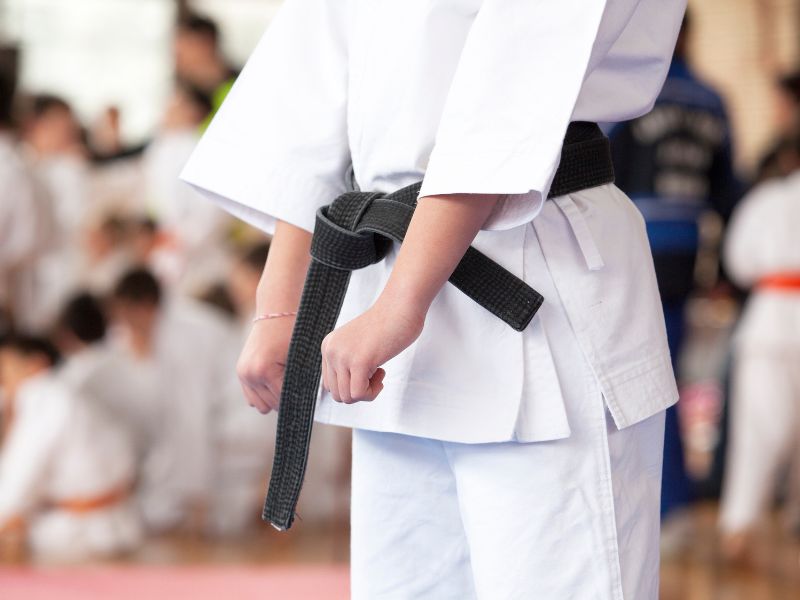
Karate is a martial art with its origins in India and China. The most popular tradition traces the origins of karate to the arrival of the Indian monk Bodhidharma in China.
He imposed the most severe discipline on the monks under him at the monastery of Shaolin, and they became famous for their physical prowess as well as their mental discipline.
The techniques of karate were introduced into the Ryukyu Islands in either the 15th or 16th century, and they continued to be refined over time.
During the Ryukyu Islands' history of tyranny, possession of weapons was forbidden for civilians, leading to an increased interest in unarmed combat.
Karate was eventually introduced to the public in Okinawa and then Japan, with Gichin Funakoshi becoming the supreme instructor of Karate-Do.
Funakoshi's systemized approach helped to codify and popularize Karate, leading to its spread throughout the world.
Today, Karate is practiced by people of all ages and levels of ability, from young children to seniors. It is an excellent way to improve fitness, flexibility, coordination, balance, and focus, while also learning self-defense skills.
Of course, this is only a brief history and understanding of Aiki Jujutsu and Karate, but if you want to go deeper into either art, be sure to check out the following posts:
Now, back to the comparison...
Let's look at the origins of the respective disciplines and then compare the key elements of their practices. You will be able to understand some of their similarities and differences a bit better afterward.
| Aiki Jujutsu | Karate | |
| Origins | Japanese | Okinawan |
Key Elements Of Aiki Jujutsu
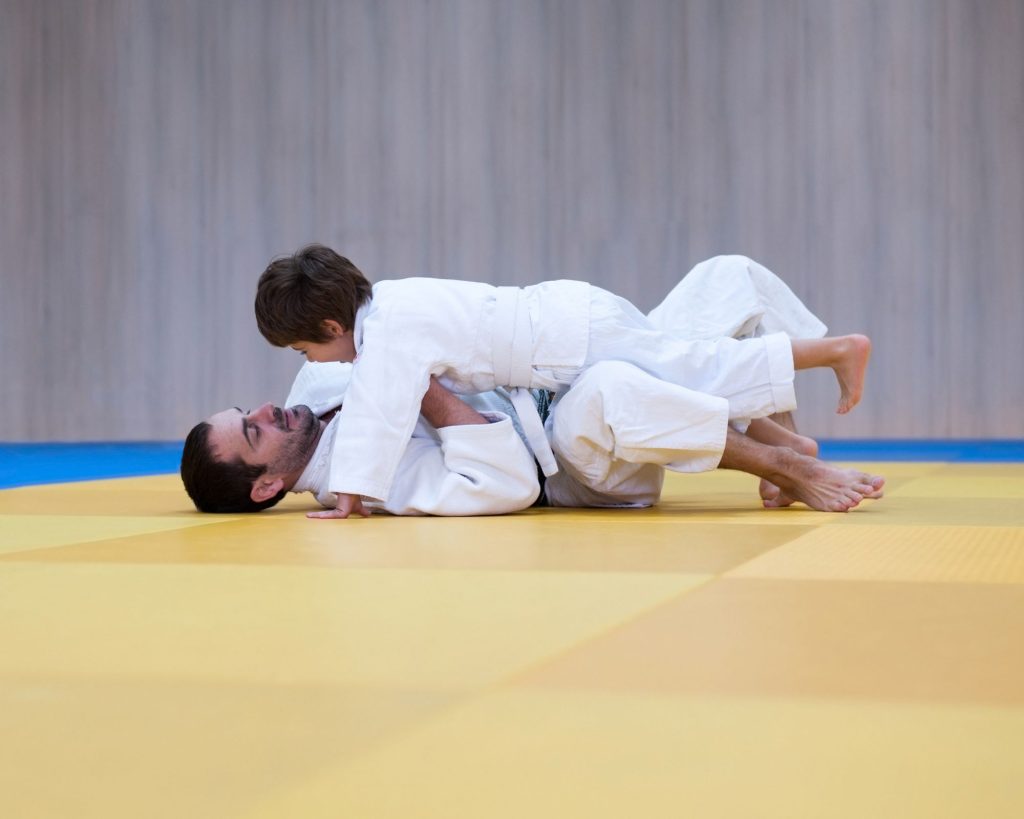
One of the fundamental principles in Aiki Jujutsu is the use of leverage and balance to gain an advantage over one's opponent. This involves the strategic application of force and momentum to manipulate an opponent's body, making it easier to control and overpower them.
Another essential component of Aiki Jujutsu is the use of body movement and positioning.
By carefully positioning one's body in relation to the opponent, a practitioner can create openings for attacks or defensive maneuvers. This requires a high degree of spatial awareness and precision in movement.
Joint locks and throws are powerful techniques that can be used to subdue an opponent quickly and efficiently.
These maneuvers involve applying pressure to a joint or manipulating an opponent's balance to throw them to the ground. They require a thorough understanding of anatomy and a high degree of technical skill.
One of the most advanced techniques in Aiki Jujutsu is the ability to blend with the motion of an attacker. This involves moving in a way that allows a practitioner to avoid incoming attacks while simultaneously positioning themselves to counterattack.
It requires an acute awareness of an opponent's movements and a high level of skill in evasive maneuvers.
Next, up here in Aiki Jujutsu is breath control. By learning to regulate their breathing, practitioners can maintain their focus and energy levels, even in the face of physical exertion and stress.
Mental focus and calmness in the face of adversity are critical traits for any Aiki Jujutsu practitioner.
And speaking from personal experience, if you're knee deep into a fight, you'll want to know how to maintain a clear head and a calm demeanor, even in the face of obvious danger.
This requires mental fortitude and the ability to stay focused under pressure, the kind that Aiki Jujutsu will teach you.
Finally, one of the most powerful parts of this martial art is its ability to use an attacker's energy against them.
By skillfully redirecting an opponent's momentum, a practitioner can use their strength and force to overpower them. Of course, this requires a deep understanding of the techniques and a high degree of technical skill--which, trust me, your training will be able to give you in spades.
Key Elements Of Karate
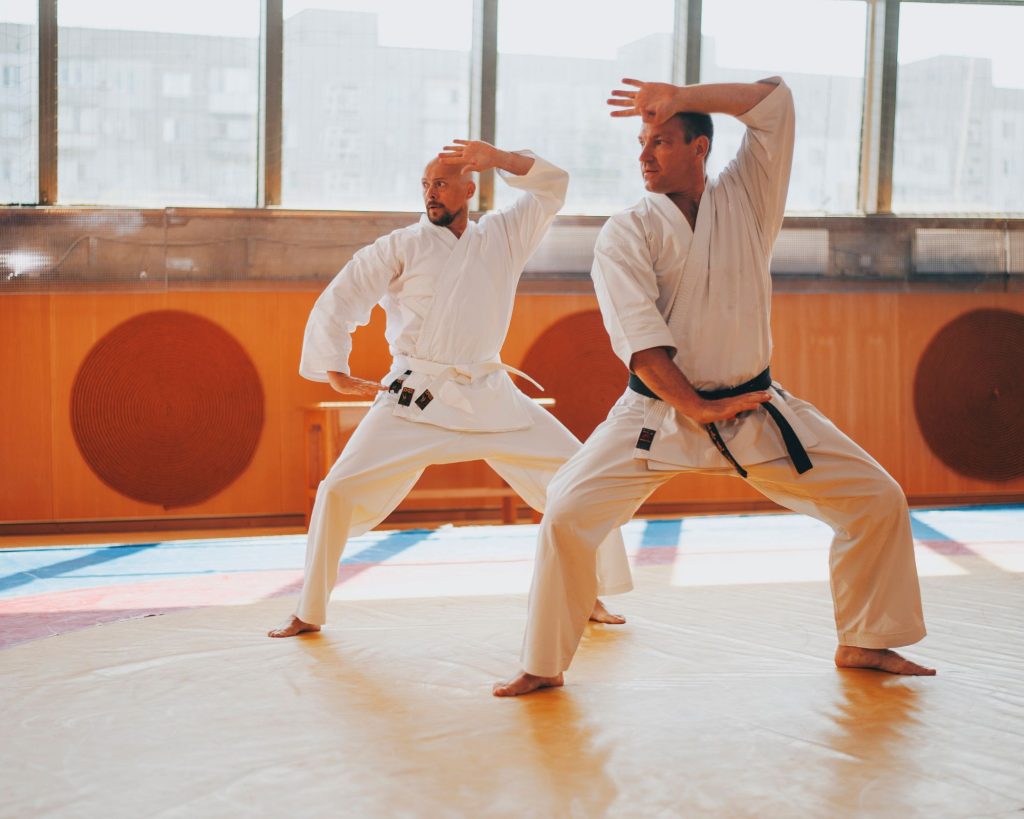
Karate is a martial art known for its striking techniques, especially which involve both punches and kicks--but there's more to it than just that.
Karate also includes grappling techniques, like takedowns and submissions, which can be used in conjunction with the striking techniques to take an opponent down and submit them.
Timing and distance are critical components of karate as well, allowing practitioners to execute their techniques with precision and effectiveness.
Balancing and positioning are also important, as they help ensure that the practitioner can maintain their stability while striking or grappling, and that they can control their opponent's movements.
Footwork is another essential element of karate, allowing practitioners to move fluidly and quickly around the mat. It also plays a significant role in timing and distance management, helping to position the practitioner in the optimal spot for executing techniques.
Power generation is the final key element of karate, as it involves the ability to generate force and momentum in one's techniques.
This is done through proper body mechanics, such as hip rotation, weight transfer, and breath control, which allow the practitioner to unleash powerful strikes and takedowns.
Together, these six elements form the foundation of karate and make it a complete and effective martial art.
Another thing I think is important to look at is the different rankings and levels in each art. if you are looking to take up either Aiki Jujutsu or Karate, whether as a hobbyist or to compete, you need to understand the different levels of proficiency and what is required for testing and ranking.
Aiki Jujutsu Rankings & Levels

Aiki Jujutsu has its own ranking system, as you've likely already expected. It starts with the 10th Kyu white belt, which represents the beginner level. As one progresses, they move up the ranking system by earning colored belts and stripes.
The ranking system is divided into two categories: kyu and dan. Kyu represents the colored belts that one earns before reaching the black belt level. Dan represents the black belt levels.
The colored belt levels range from 9th Kyu white belt with a yellow stripe, all the way to 4th Kyu purple belt.
The amount of training required to earn these belts is pretty significant, in my opinion. IT ranges from 2 to 3 months, such as for the 9th Kyu white belt with a yellow stripe, to 15 to 21 months, like for the 4th Kyu purple belt.
The black belt levels start with the Shodan-Ho (Junior Black Belt) and progress to the highest level, which is the Godan (5th Degree Black Belt).
If you ask me, it's definitely not an easy feat to achieve: it normally takes years of dedication and training to reach the highest levels of the black belt ranking system.
If this is all a bit hard to visualize, don't worry; I've made a more detailed breakdown for you to see below:
| Rank | Color |
| 10th Kyu | White |
| 9th Kyu | White |
| 8th Kyu | Yellow |
| 7th Kyu | Blue |
| 6th Kyu | Green |
| 5th Kyu | Green |
| 4th Kyu | Purple |
| 3rd Kyu | Brown |
| 2nd Kyu | Brown |
| 1st Kyu | Brown |
| Shodan-Ho | Black |
| Shodan | Black |
| Nidan | Black |
| Sandan | Black |
| Yondan | Black |
| Godan | Black |
Karate Rankings & Levels
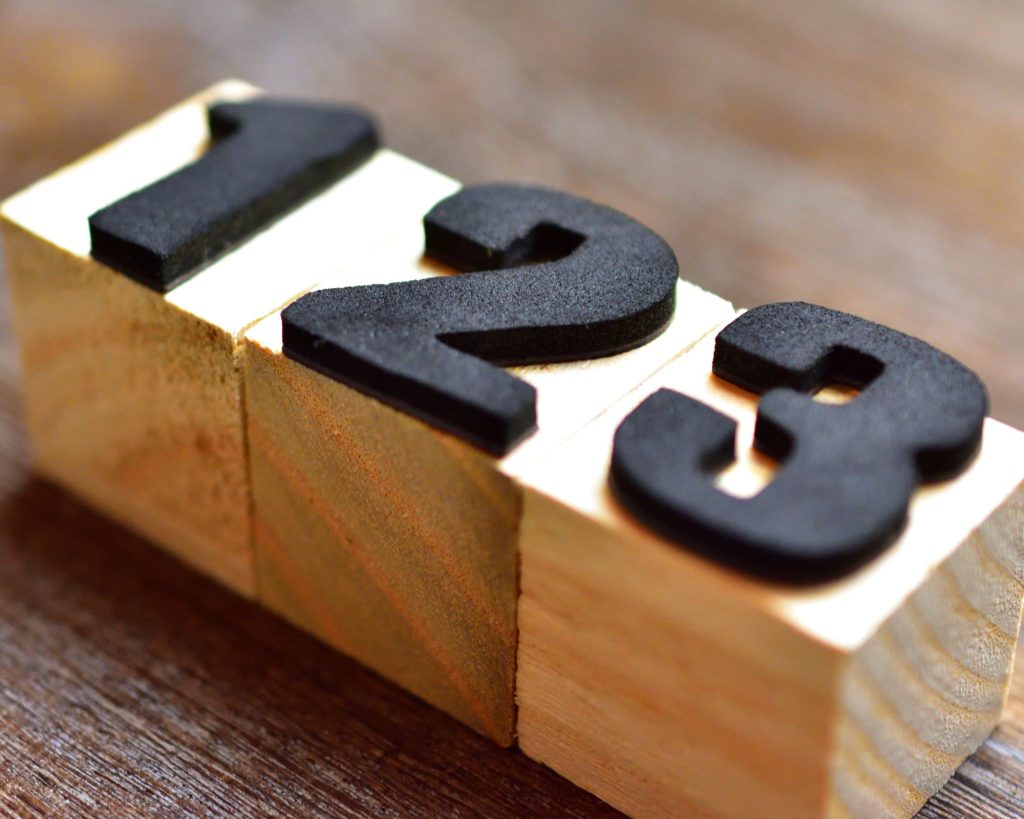
Karate Belts
The New Kyokushin Karate Belt System is a ranking system that consists of 10 kyu, or levels. There are 6 belt colors: white belt, orange belt, blue belt, yellow belt, green belt, and brown belt. All belts besides the white belt can have dashes to indicate further progress.
The purpose of the New Kyokushin Belt System is to acknowledge a student's progress and award them with a new colored belt when they have mastered the techniques and skills required for that level.
The New Kyokushin Belt System is divided into 3 sections: junior belts (white belt - orange belt), intermediate belts (blue belt - brown belt), and black belts.
In order to progress from one section to the next, a student must pass an examination that tests their knowledge of the techniques and skills required for that rank.
Junior belts must pass a White Belt Exam, intermediate belts must pass a Blue Belt Exam, and black belts must pass a Black Belt Exam.
The New Kyokushin Belt System is designed to be more challenging and progressive than the old Kyokushin Belt System. In the old Kyokushin Belt System, students progressed through the ranks by completing set number of stripes on their belts.
This system wasn't very challenging or progressive, especially because it did not take into account a student's ability or level of mastery.
The New Kyokushin Belt System, on the other hand, is more challenging because students must pass an exam in order to progress to the next rank.
It's more progressive too, because students can better earn different belts by mastering different techniques and skills.
Karate Belt Examination Standards
Karate belt examinations and progression are an important part of the martial art. They are a way to measure a student's progress and ensure that they are learning material correctly. The minimum time limits between belt examinations are listed below.
- 10th Kyu to 3rd Kyu: Minimum 4 months between grades
- 3rd Kyu to 1st Kyu: Minimum 6 months between grades
- 1st Kyu to Shodan: Minimum 12 months between grades
- Shodan to Nidan: Minimum 2 years between grades
- Nidan to Sandan: Minimum 3 years between grades
- Sandan to Yondan: Minimum 4 years between grades
- Yondan to Godan: Minimum 5 years between grades
- Godan to Rokudan: Minimum 6 years between grades
These minimum time limits are just guidelines though, and they can vary depending on the individual's progress, ability, and commitment.
Remember that belt progression is not a competition or race. The main goal is to properly learn and master the techniques and skills required for each belt level.
It's better to take more time in between examinations if necessary, rather than rushing through the ranks without fully understanding the material.
Aiki Jujutsu Vs. Karate Attire
This section simply compares the clothing and uniforms that practitioners wear in combat.
Aiki Jujutsu Attire:
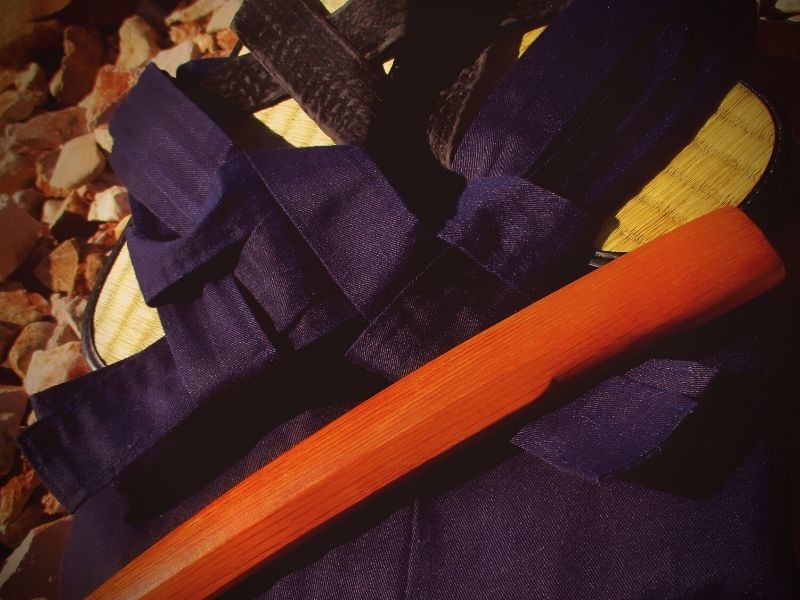
In terms of attire, Aiki Jujutsu practitioners typically wear a traditional dogi and hakama. This affords them better gripping and movement during techniques.
Karate Attire:
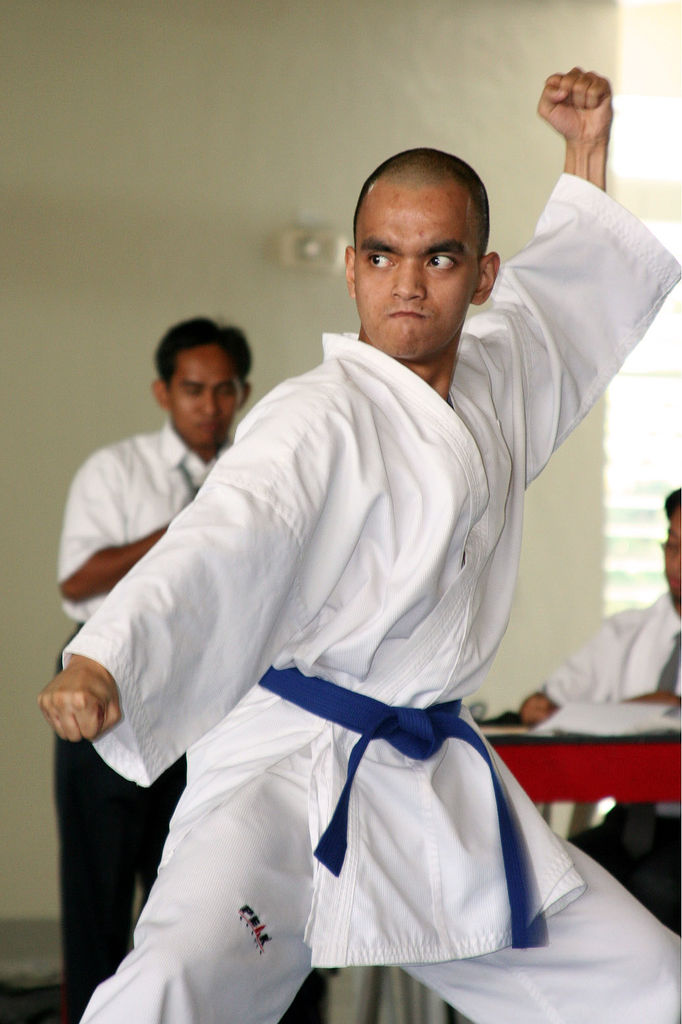
Karate practitioners generally wear a gi, which is a type of uniform typically made of cotton or polyester. The gi pants have a tie string waist and the jacket has a round neck and long sleeves.
What A Typical Aiki Jujutsu Training Session Looks Like
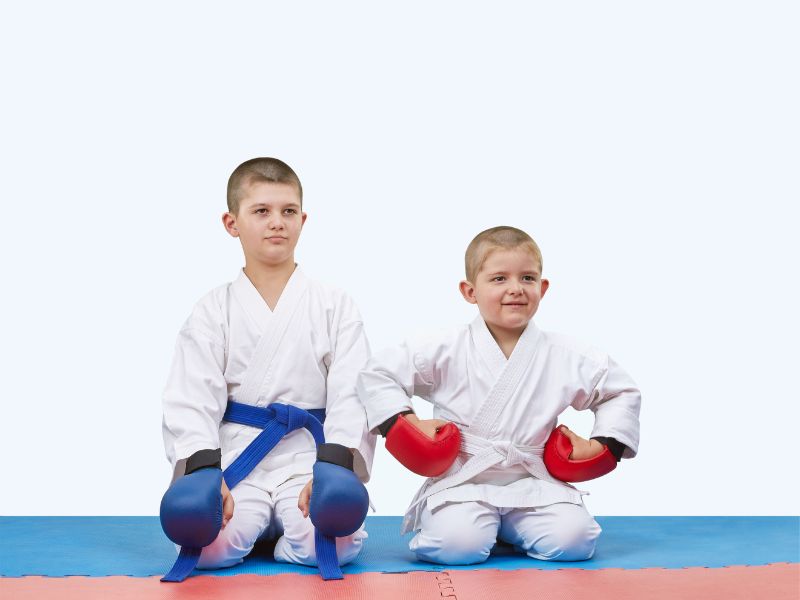
A typical Aiki Jujutsu practice session may start with a few minutes of warm-ups, such as joint rotations and light stretches. This is followed by practicing techniques, which may include throws, locks, and pins. The session usually ends with some relaxation exercises and a cool-down.
One of the most commonly used techniques in Aiki Jujutsu is the wristlock. This involves controlling an opponent's wrist and using their own momentum to throw them off balance.
In addition to physical technique, Aiki Jujutsu also emphasizes mental and spiritual development. This includes cultivating a strong mind-body connection and developing qualities such as patience and awareness.
What A Typical Karate Training Session Looks Like
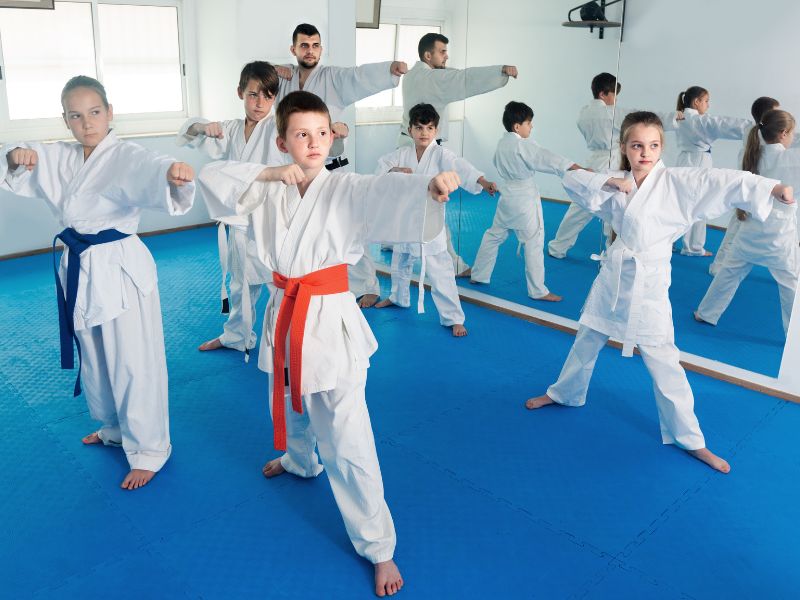
A typical karate practice class will begin with a warm-up. This may include some light calisthenics such as jumping jacks and running in place. The purpose of the warm-up is to get your heart rate up and to loosen your muscles.
The next part of the class will focus on technique. You will learn different punches, kicks, and blocks. The instructor will demonstrate the techniques and then you will practice them with a partner.
Sparring is another important part of Karate. Sparring is when two people fight each other using the techniques they have learned. This is done with protective gear such as gloves and pads.
Remember that Karate is not just about fighting. It is also about discipline and respect. At the end of each class, there is usually a period of meditation where you can reflect on what you have learned.
If the last few sections have been a bit full-on or a bit too technical, you will like this next section! Why? Because who doesn't love a good martial arts flick?
Both Aiki Jujutsu and Karate have been featured in a number of films and TV shows, so if you want to learn more about them, then entertain yourself with the following 👊
Aiki Jujutsu Movies

These are some of my favorite movies and shows with Aiki Jujutsu in them:
- The Bourne Identity (2002)
- Kill Bill: Volume 1 (2003)
- The Protector (2005)
- The Matrix Reloaded (2003)
- 13 Assassins (2010)
- The Raid (2011)
Some of the best movies with Karate in them, though you'll never guess from their titles, are:
- The Karate Kid (1984)
- The Karate Kid Part II (1986)
- The Karate Kid Part III (1989)
- Karate Girl (2011)
- Karate Kill (2016)
Conclusion: Aiki Jujutsu Vs. Karate
I hope you now have a deeper understanding of Aiki Jujutsu and Karate. In all truth, it is not about which discipline is "better" as they each have their pros and cons.
If you do plan on starting classes for either, please check out my other related posts, as I have tried my best to answer all the FAQs related to the art.
Feel free to share this post and any graphics you like, and of course, if you have any questions or thoughts, drop them below or shoot me an email, and I will be happy to assist 🙂
[author-box-jpx-fitness]
